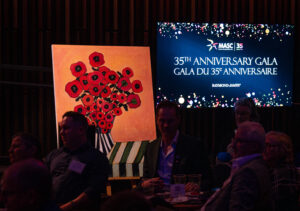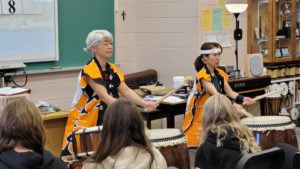Interview: Rag & Bone Puppet Theatre explore infinite world of possibilities in puppetry
By Jessica Ruano | January 6, 2022

This interview was originally published on Apt613.ca
Rag & Bone Puppet Theatre has toured across Canada and the U.S. since 1978 with over 100 performances a year in schools, libraries, children’s festivals, and theatres. Kathy MacLellan has also written for children’s TV shows including Mr. Dressup, Under the Umbrella Tree, and Theodore Tugboat. John Nolan appeared as Jackson on the YTV show Crazy Quilt. In this interview, Kathy talks about the infinite world of possibilities in puppetry — whether live onstage or at a distance on screen.

Kathy MacLellan of Rag & Bone Puppet Theatre. Photo provided by MASC.
MASC: You may not know this about me, but I am a total puppet nerd, and in fact dedicated part of my Master’s thesis to deconstructing puppet theory, recognizing puppets as balancing on the threshold between life and death, embodying the qualities of both animate and inanimate objects… Do you think much about the philosophy and theology behind puppeteering, and how does that translate into your work?
The philosophy and theology are, in a nutshell, the magic of puppetry. A puppet is an abstract object. It encourages the audience to use their imagination and suspend their disbelief. This gets them more involved.
I pour my thoughts and feelings into the puppet, audience members project their own thoughts and feelings onto it, and we meet in the middle. As puppeteers, we have control over this little world, but in our approach, it’s a benign and loving authority, “comme des anges.”
Using puppets gives us freedom – a character can fly, jump off a roof, or dance on a teacher’s head. We are also inspired by the way that children play with toys – creatively, imaginatively, and cooperatively. When kids play like that with toys, they learn that they can shape their own stories, and perhaps their own destinies. Maybe change the world into a more loving, co-operative, and benevolent place.
Does the inside of your house look like a magical puppet fantasy land? Otherwise where do you create your puppets and where do you house all your creations and materials?
We live in a wonderfully normal-looking house in Orleans, with a two-car garage and an unfinished basement. The garage has shelving on three sides, full of sturdy boxes containing sets, props, and puppets for twenty different shows.
Various creative projects are always on the go in the main part of the house – sewing, knitting, design sketches, creative writing ideas, and the computers that help run the business. The basement is action central for John’s woodworking, sculpting, and bicycle maintenance. It’s also home to a lot of storage for items that could make it into a show some day – fabric, costumes, hats, interesting antique objects, and old toys. We love toys! Toys from our childhoods, toys that our kids have outgrown, and toys from thrift stores. And lately, the basement has also become a surprisingly well-equipped studio for recording, streaming, and hosting online events.
With your live performances, you present intimate and innovative theatre experiences for school and family audiences. How has this changed with your online programming? What new discoveries have you made about your art form and how you connect with audiences?
With our new basement studio, using close-ups, eye contact, and live interaction, we can be even more intimate and innovative! Our first event was the livestream of Felicity Falls, through the National Arts Centre’s #CanadaPerforms program. With one camera in a fixed position, we took a week to figure out how to move into close-ups and long shots, keep all the props organized, and keep going for the whole show.
We had over 3,000 views, and many heartwarming comments. Since then, we have taught drama classes online with Ottawa Children’s Theatre, performed online for a Montreal library and, thanks to Ottawa Community Foundation, launched Snippets — staged readings with special guests. Our first guest was Nadia Sammurtok from Iqaluit, and the audience included people from as far away as Vancouver and Mexico! Schools and communities can book a whole show from us — like Felicity Falls — or one story, like Peter Rabbit, from “Hippity Hoppity Snippets.”

Kathy MacLellan and John Nolan of Rag & Bone Puppet Theatre. Photo provided by MASC.
As a member of MASC, what do you gain through offering your workshops in schools and in the community?
Some of my most poignant memories feature work with kids who have special needs: one girl who had never spoken before suddenly found her voice to make her puppet talk; another boy joined a group in one of our workshops and, for the first time ever, made friends at school.
I love the roar of the crowd when something is funny, and the absolute silence in a moment of tension. I also love how MASC connects us with other artists who work in schools and communities like we do. It’s great to share and learn from their experiences and approaches.
I value the input, advice and friendship I’ve had for many years with MASC staff, brainstorming solutions, fleshing out ideas, and sharing laughs. As Chair of the MASC Board of Directors for many years, I am very proud of things that were accomplished during my tenure.
Why do you think it’s important for our local community to have access to professional artists?
Art experiences and communal events are essential to any community’s quality of life. When a school group meets in the gym, staff and kids laugh together, think about new things, learn a bit about empathy and caring, see things from another point of view, and talk about it afterwards.
It’s also important that people see artists who live in their own city, that it’s possible to make a living in the arts, find a job that you love, work at something meaningful, and feel that you are making a difference. Some kids love sports and find a place to belong in that world. Others will only thrive and survive if they can find a way to express themselves through the arts. In our small way, we are throwing a lifeline to those kids. Life is beautiful and worth living, we say to them, and so are you.
Latest News
View All Articles



